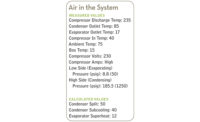This ice machine incorporates a critical charge (46 oz) of R-402B, a near-azeotropic, HCFC-based refrigerant blend of 38% R-125, 2% R-290, and 60% R-22. This ice-making machine also contains two evaporators, two non-adjustable TXVs, a hot gas defrost system, liquid receiver, coaxial (tube within a tube) water-cooled condenser, and a water-regulating valve (Figure 1).
The water-cooled condenser adds to the compactness and quietness of the system. The amount of ice produced per day is dependent upon the incoming water temperature to the evaporator’s sump and to the surrounding air temperature around the ice machine.
Notice in Chart 1, that as the entering water temperature gets warmer, the ice-making capacity decreases. Also, as the surrounding air temperature gets warmer, the ice-making capacity decreases. Both conditions of warmer entering water and surrounding air temperatures add extra heat load on the evaporators of the ice machine. Thus, the time it takes to make a complete slab of cubed ice is longer. The capacity of the ice machine is decreased in both situations.
This ice machine is located at Ferris State University’s Commercial Refrigeration Laboratory in Big Rapids, MI, and is used daily by students and university personnel. The machine is operated every day of the year.
The ice machine was first critically charged, followed by intentional overcharging and undercharging to see what inefficiencies in ice-making capacity, if any, would be observed.
Chart 2 shows the pertinent system information of three system checks for a critical charge, undercharge, and an overcharge of refrigerant. This chart also reveals that for the critical charge, undercharge, and overcharge of refrigerant, all system data pretty much look alike and are acceptable.
The condensing temperature, condenser subcooling, evaporator superheat, and compressor (total) superheat all pretty much look similar, whether the system is critically charged to the nameplate charge, overcharged by 5 oz, or undercharged by 5 oz. What follows are explanations of these system operating conditions.
Condensing pressure and temperature
The condensing temperature is controlled by a water-regulating valve (Figures 3 and 4). This valve is designed to maintain a constant condensing head pressure whatever the heat load on the ice machine may be.The water-regulating valve is in series with the water-cooled condenser (Figure 4). The valve has a closing pressure mechanism that is a large adjustable spring on its top. This adjustable spring is where the technician can set the desired condensing pressure.
The valve’s opening force is the condensing pressure, which acts on a bellows on the bottom of the valve. The bellows are connected directly to the high side of the refrigeration system through a capillary tube to sense condensing pressure.
As the condensing pressure increases, the valve opens to let more water through the water-cooled condenser. This higher water flow rate will lower the condensing pressure to the set spring pressure.
Conditions that could cause the water-regulating valve to throttle more open and cause an increased water flow through the condenser could be an overcharge of refrigerant, high evaporator loads from warm incoming sump water, a high ambient around the machine, or a fouled condenser, to mention a few.
If condensing pressure decreases, the bellows pressure will be lower and the spring will throttle the valve to a more closed position. Thus, the condensing pressure will again remain constant at varying system conditions.
Conditions that would cause the water-regulating valve to throttle more closed could be an undercharge of refrigerant, cold sump water entering the evaporator at the end of an ice-making cycle, colder inlet water temperatures to the machine, or a cold ambient around the ice machine.
Varying system conditions in this experiment were an overcharge and undercharge of refrigerant. The water-regulating valve reacted by either increasing or decreasing flow through the water-cooled condenser to maintain the set condensing pressure of 225 psig (98°F). The only change in the system was a larger flow of water through the condenser in the overcharged system, and a smaller flow of water for the undercharged system.
These changes are often gone unnoticed by service technicians.
Subcooling, superheat
Condenser subcooling pretty much remained the same for the critical, overcharged, and undercharged systems.Remember that the water-regulating valve allowed for increased water flow through the water cooled-condenser on the refrigerant overcharge. This increased water flow absorbed more heat from the greater amount of liquid that formed in the condenser from the overcharge of refrigerant.
The decreased water flow through the condenser for the undercharge did not have to absorb as much heat because of less liquid in the condenser. This explains why the subcooling pretty much remained constant in all three scenarios.
The two metering devices in this ice machine were nonadjustable TXVs. A TXV’s function is to keep a constant amount of superheat in the evaporator under all heat-loading conditions. The TXV can do this only if it is supplied with 100% liquid and system pressures do not exceed the operating range of the TXV.
In this experiment, the operating pressure ranges of the TXV were not exceeded in the overcharge or undercharge of refrigerant because constant condensing pressures were held with the water-regulating valve. Also, the undercharge of refrigerant was not severe enough to starve the system of liquid.
The receiver in the system (upper left in Figure 2) helped store subcooled liquid from the condenser to supply to the TXVs when needed. A more severe undercharge may have taken the 100% liquid away from the TXVs and hampered their ability to keep a constant superheat.
Since the suction lines were approximately the same length and were insulated (Figure 2), the compressor superheats remained pretty much the same.
This ice machine is considered a very forgiving machine simply because of its ability to handle an array of varying system conditions and charges and still make quality ice.
The fact that it has a water-regulating valve, TXVs, a water-cooled condenser, and a receiver on a critical-charged system gives it the ability to be quite a bit forgiving.
In this experiment, no differences in ice quantity were noticed even when a 5-oz overcharge and undercharge were observed in the system when compared to the critical charge of refrigerant. The undercharge of 5 oz was not enough to starve an evaporator and cause a high evaporator superheat condition, thus less ice.
Even though the water-cooled condenser adds to the quietness and compactness of the system, one must remember that the increased water flow through the condenser on the overcharged system may be objectionable to some owners because of cost and/or availability of water in certain regions.





